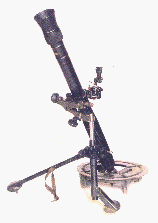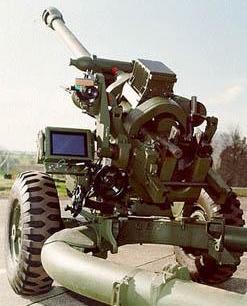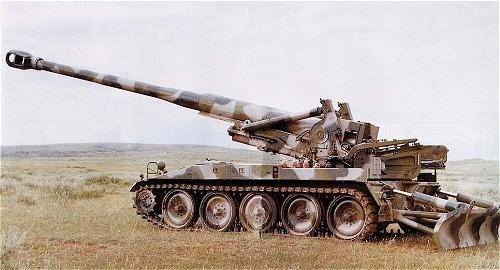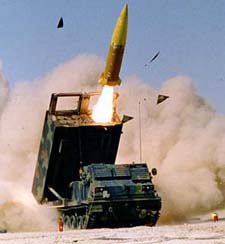Real-life Artillery
The modern artillery piece is an incredibly lethal and (in the public eye) totally unappreciated piece of machinery. It lacks the popularity and accessibility of the personal firearm or the glamour of the main battle tank, but artillery is an absolutely crucial component of combined-arms tactics in ground warfare. Sci-fi fan discussions of ground warfare often assume that artillery is unnecessary in the presence of air support, but this is a totally unrealistic approach. While artillery doesn't produce pretty pictures of smart bombs hitting buildings for CNN, it does produce results, particularly against targets which are not easily seen from the air. Unlike aircraft, artillery is unaffected by cloud cover or similar visibility conditions; as long as the spotter can relay the target location, the act of aiming is performed through mathematical computation rather than visual target acquisition.
Furthermore, artillery isn't as easily fooled by cardboard decoys or other guerilla tricks, since its targeting is based on forward observers rather than detection from a distance. An artillery piece is also much less expensive than an aircraft, and a high explosive shell is much less expensive than a multi-million dollar guided missile. Artillery has an effective 100% duty cycle in the local combat area, unlike aircraft which cover large areas and must periodically return to base for refueling, maintenance, etc. Artillery is also much harder to detect than aircraft. Even a stealth aircraft is neither invisible or silent, while a camouflaged artillery piece can avoid detection until it opens fire, even in daytime.
Artillery pieces can range from small 52mm mortars to massive 8-inch self-propelled howitzers such as the M110A1, and they serve two purposes: close-range infantry support and long-range destruction of enemy units. Since artillery fires projectiles in an arcing trajectory, it has the absolutely priceless ability to hit targets without a line of sight. The importance of this capability simply cannot be overstated. An enemy tank column can be attacked by field artillery from behind geographical obstructions, and even if the attacking artillery is within range, the tanks still wouldn't be able to shoot back. In mountainous terrain, this capability is absolutely crucial; an army without artillery is a dead army. Of course, this leads to the obvious question of how artillery is aimed, and that job falls to fire control and the forward observer.
Forward observers operate independently, and their job is to locate the target. They can be anything from specially equipped vehicles to men on foot, and they are typically equipped with laser rangefinders and accurate positioning systems such as GPS systems, so that they can relay very accurate targeting data back to fire control. Fire control then performs mathematical computations to determine the ideal firing angle and charge in order to hit the target, factoring in such variables as wind, humidity, temperature, etc. Modern systems even have multiple simultaneous strike capability, which is accomplished by firing three times in rapid succession: once at very high elevation, once at medium elevation, and once at low elevation. All three shots are timed so that they hit the target at the same time, from three different angles. Against a hardened target, this can effectively triple the power of the weapon. Against soft targets like infantry, the approach is somewhat different; a single proximity-fused projectile is set to explode in the air above the target and shower it with shrapnel. Either way, whether the target is a bunker, a column of armoured vehicles, or a group of infantry, if the artillery can find it, the artillery can destroy it.
Unfortunately, the greatest advantage of the artillery piece is also its greatest weakness: the parabolic trajectory of its projectile. While it allows the artillery piece to hit its target at great distances without a line of sight, it also allows a well-equipped enemy to swiftly locate the artillery piece, simply by tracking the arc of its projectile and mathematically computing its source. Specialized systems have been designed for just this purpose: for example, the EMI Cymbeline radar system is a specialized mortar-locating radar system, and the US Army's Firefinder system can locate both mortars and field artillery pieces. This means that field artillery is as much of a target as a threat, and the best efforts at concealment are basically for naught when the gun is ordered to open fire. However, the enemy must be well equipped in order to exploit this weakness, thus further underscoring the necessity of artillery: an enemy without effective artillery of his own would be helpless to exploit this weakness, so you would be able to attack him with impunity.
Another point of vulnerability is the forward observer, since your artillery cannot target the enemy if your forward observers have been killed or captured. A possible alternative to the forward observer is the small aerial RPV (remote piloted vehicle), which is already in use for naval gunnery. However, the RPV is an expensive device, and forward observers are expected to be available on the battlefield by the time artillery is deployed. A brief listing of basic artillery categories follows.
Mortars
 Mortars
are small, portable artillery pieces with barrel diameters ranging
from 51mm to 120mm. Their ranges can be anywhere from 50m to more
than 7 km, and they can fire projectiles as small as 2 kg or as large
as 15 kg. Mortars have a very high refire rate, and some of them can
fire projectiles as rapidly as once every two seconds. The
accompanying picture depicts an M252 81mm medium mortar, which has a
maximum range of 5700 metres and a mass of roughly 40 kg. The primary
specialization of the mortar is close-range indirect fire support,
since they have very short minimum ranges, they travel with the
infantry, and they aren't as powerful as field artillery.
Mortars
are small, portable artillery pieces with barrel diameters ranging
from 51mm to 120mm. Their ranges can be anywhere from 50m to more
than 7 km, and they can fire projectiles as small as 2 kg or as large
as 15 kg. Mortars have a very high refire rate, and some of them can
fire projectiles as rapidly as once every two seconds. The
accompanying picture depicts an M252 81mm medium mortar, which has a
maximum range of 5700 metres and a mass of roughly 40 kg. The primary
specialization of the mortar is close-range indirect fire support,
since they have very short minimum ranges, they travel with the
infantry, and they aren't as powerful as field artillery.
As with all weapon classes, the mortar complements the weapons
above and below it. It can hit targets that small-arms fire cannot,
and with explosives rather than bullets. It also takes some of the
load off the field artillery by performing the close-support work,
thus freeing up the field artillery to fry bigger fish.
Towed Guns
 Towed
guns are, as the name implies, artillery pieces that must be towed by
another vehicle. They are more powerful than mortars, and they have
greater range. The M198 155mm howitzer, for example, can hurl a wide
variety of 155mm projectiles as far as 18 km (33 km with rocket
assist). It can also be used for multiple simultaneous strikes, and
it can fire high explosive shells, anti-personnel or anti-armour
mine-laying systems, tactical nuclear warheads, chemical weapons,
smoke projectiles, communications jamming devices, remote sensors,
illuminating projectiles, and even special guided projectiles. It is
more than capable of destroying infantry, buildings, or armoured
vehicles, so it is used to hit "deep targets" well behind
the front lines. This can include armoured columns moving to the
front, enemy artillery, etc. Towed guns can even be small enough to
be highly portable. For example, the British Army has a 105mm light
gun which is air portable, yet has a maximum range of more than 17
km. The example pictured at right is equipped with a Marconi LINAPS
automatic aiming system.
Towed
guns are, as the name implies, artillery pieces that must be towed by
another vehicle. They are more powerful than mortars, and they have
greater range. The M198 155mm howitzer, for example, can hurl a wide
variety of 155mm projectiles as far as 18 km (33 km with rocket
assist). It can also be used for multiple simultaneous strikes, and
it can fire high explosive shells, anti-personnel or anti-armour
mine-laying systems, tactical nuclear warheads, chemical weapons,
smoke projectiles, communications jamming devices, remote sensors,
illuminating projectiles, and even special guided projectiles. It is
more than capable of destroying infantry, buildings, or armoured
vehicles, so it is used to hit "deep targets" well behind
the front lines. This can include armoured columns moving to the
front, enemy artillery, etc. Towed guns can even be small enough to
be highly portable. For example, the British Army has a 105mm light
gun which is air portable, yet has a maximum range of more than 17
km. The example pictured at right is equipped with a Marconi LINAPS
automatic aiming system.
However, the towed gun's primary weakness is its lack of mobility. Since a towed gun can be targeted from the flight path of its projectile, it is an obvious target for enemy counter-attack. It also has difficulty keeping up with rapidly moving mobile forces, since the number of available tractors is generally smaller than the number of guns. Therefore, the towed gun has been largely supplanted by the self-propelled gun in modern armies. However, the towed gun is much less expensive than the self-propelled gun, and in today's complex global environment, the enemy need not be a large, well-armed national military force. It could be anything from terrorists to criminal organizations, and in many cases, these enemies are poorly equipped, lacking effective field artillery or projectile tracking systems. Against such an enemy, a towed artillery piece can be a lethal and virtually untouchable implement of war.
Self-propelled Guns
Mobile warfare is hampered by immobile artillery support, so a full-scale conventional warfare scenario requires self-propelled artillery pieces such as the American M110A1. This is a self-propelled 203mm howitzer. It has been in service for decades, and can be found in the armies of numerous countries around the world. It can fire an 8-inch diameter, 92.5 kg high explosive projectile to a maximum range of 21.3 km, and a rocket-assisted projectile to a maximum range of 29.1 km. It can also fire a variety of other projectiles if necessary, like the towed M198 mentioned above, but unlike the M198, it can travel at nearly 60 km/h under its own power. It also has a shovel-like attachment which digs into the ground to stabilize the platform against the prodigious force of recoil from its massive gun. It should be noted that this gun provides no protection whatsoever for its crew, and that this sort of self-propelled gun is actually the exception rather than the rule. Most self-propelled guns have an enclosed crew cab for protection as well as greater ammo storage.

The doctrine of self-propelled gun deployment calls for large numbers of independent units to situate themselves around the countryside and move with the infantry and armour units. When a target is identified by the spotters, all of these artillery pieces will simultaneously open fire and shower it with shells, before pulling up stakes and changing positions in order to avoid the inevitable enemy artillery counter-attack (the slang term is "shoot and scoot". In this way, mobile artillery units achieve the dangerous combination of mobility, dispersion, and firepower concentration.
Rocket Artillery
 Rockets
(as opposed to guided missiles) have been used in battle
for many hundreds of years, but they fell out of fashion at the end
of the 19th century, as the lethality and accuracy of artillery
improved to such a point that rockets were no longer considered
useful. The reason was that rocket accuracy was generally poor; their
flight paths were not as predictable as the flight paths of ordinary
artillery shells. They returned in WW2 (mostly in the hands of the
Russians), who accepted their limitations and used them as an area
weapon, where they were devastating. If you lined up hundreds of
rocket launchers and fired them at a target area, they could dump
huge amounts of explosive on the target in a short period of time,
and for minimal cost.
Rockets
(as opposed to guided missiles) have been used in battle
for many hundreds of years, but they fell out of fashion at the end
of the 19th century, as the lethality and accuracy of artillery
improved to such a point that rockets were no longer considered
useful. The reason was that rocket accuracy was generally poor; their
flight paths were not as predictable as the flight paths of ordinary
artillery shells. They returned in WW2 (mostly in the hands of the
Russians), who accepted their limitations and used them as an area
weapon, where they were devastating. If you lined up hundreds of
rocket launchers and fired them at a target area, they could dump
huge amounts of explosive on the target in a short period of time,
and for minimal cost.
Modern technology has made it impractical to line up hundreds of
launchers and fire them simultaneously, because that will only
represent a juicy target for the enemy. However, modern technology
has also made the vehicle-mounted multiple-rocket launcher system a
dangerous weapon even when alone. Modern rockets are more accurate,
with better targeting systems built into the launch vehicle.
Furthermore, modern warheads are often designed for chemical
airbursts or area dispersal of sub-munitions such as mines, thus
reducing the importance of accuracy. The American MLRS
(multiple-launch rocket system) is a good example of this type of
weapon, with hundreds in service. They acquitted themselves
satisfactorily in the 1991 Gulf War, and despite a brief absence in
the early part of the 20th century, the rocket launcher is still an
important element in a ground army's arsenal. They have limited
accuracy but they are a good area weapon and they are inexpensive,
thus ensuring their continued usefulness.
Enough real artillery. Let's see what big guns the Empire has!